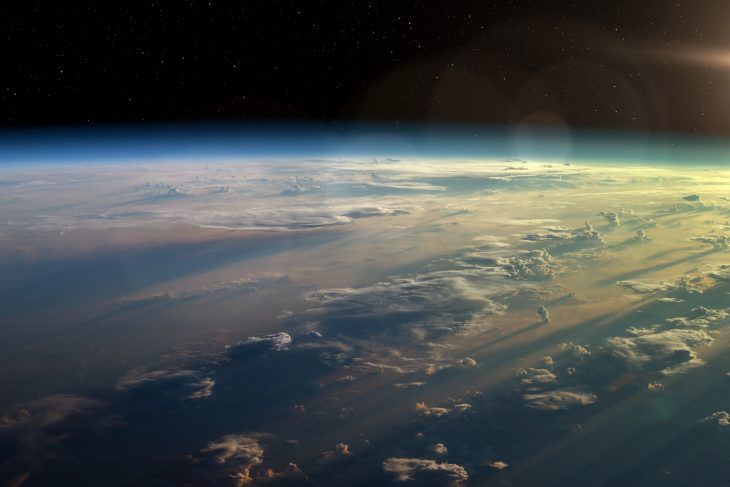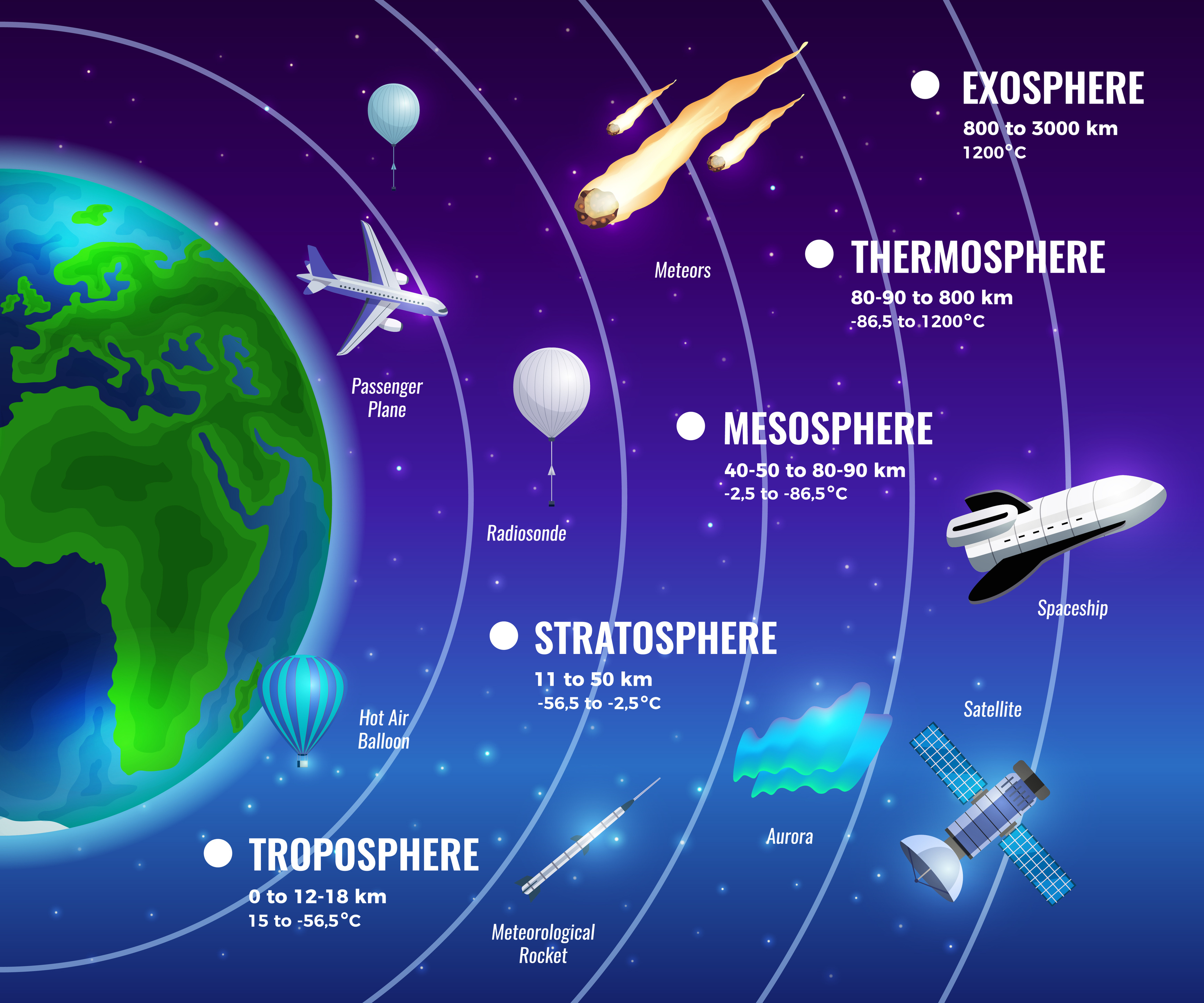
If you’re a space enthusiast, then you’ve likely heard of the mesosphere before. Located in the upper atmosphere between 50 to 85 kilometers above Earth’s surface, the mesosphere is an important atmospheric layer that plays a key role in climate and weather patterns. It’s full of fascinating discoveries and intricate scientific understandings.
With this article, we’ll be exploring virtually unknown facts about this incredible area — from its temperature variations to its eerie blue nightglow appearance due to gases such as nitrogen and oxygen! Read on for 20 must-know facts about our ever-so-mysterious mesosphere.

Location
The mesosphere starts at an altitude of approximately 50 kilometers (31 miles) above the Earth’s surface and extends upwards to around 85 kilometers (53 miles).
Temperature
The temperature in the mesosphere decreases with altitude, making it the coldest layer of Earth’s atmosphere. Temperatures can drop to as low as -90°C (-130°F) at its highest point.
Composition
The mesosphere consists mainly of nitrogen, oxygen, and trace amounts of other gases like carbon dioxide, water vapor, and helium. The gas composition is similar to that of the troposphere, but the gases are much less dense in the mesosphere due to the higher altitude.
Atmospheric Pressure
Atmospheric pressure in the mesosphere is significantly lower than at the Earth’s surface, with pressure decreasing as altitude increases. The pressure in the mesosphere is less than 1% of the pressure at sea level.
Meteors
The mesosphere is commonly referred to as the “meteor layer” because most meteors burn up upon entering this part of the atmosphere. Friction between the meteors and the sparse air molecules generates heat, causing the meteors to disintegrate.
Noctilucent Clouds
Rare, luminous cloud formations called noctilucent clouds can be observed in the mesosphere. These clouds are composed of ice crystals and are visible during twilight, when the sun is below the horizon but still illuminates the high-altitude clouds.
The Mesopause
The boundary between the mesosphere and the thermosphere is called the mesopause. The mesopause is the point at which the temperature reaches its minimum before starting to increase again in the thermosphere.
Atmospheric Tides
Atmospheric tides are global-scale waves that propagate through the atmosphere, and they are particularly pronounced in the mesosphere. These tides are caused by the gravitational pull of the moon and the sun, as well as by daily variations in solar heating.
Turbulence
The mesosphere is characterized by strong turbulence due to the mixing of air masses with different temperatures and densities. This turbulence contributes to the transport of energy and chemicals throughout the atmosphere.
Vertical Winds
In the mesosphere, vertical winds can reach speeds of up to 100 meters per second (328 feet per second). These winds help transport gases and other materials between the mesosphere and the layers above and below it.
Research Challenges
Studying the mesosphere is challenging due to its location, as it is too high for weather balloons and too low for satellites. Consequently, our understanding of this atmospheric layer is more limited than that of the other layers.
Sounding Rockets
Sounding rockets are small, suborbital rockets that can reach the mesosphere and collect data on its properties, such as temperature, pressure, and composition. These rockets are an essential tool for studying this elusive layer of the atmosphere.
The Andes Lidar Observatory
The Andes Lidar Observatory in Argentina is dedicated to studying the mesosphere using a laser radar (lidar) technique. This observatory helps scientists better understand the mesosphere’s dynamics and structure by providing valuable data on its temperature, winds, and other properties.
Gravity Waves
Gravity waves are disturbances in the atmosphere that propagate vertically and can affect the mesosphere. These waves are generated by various processes, such as airflow over mountains and thunderstorms. Gravity waves can impact the temperature, wind patterns, and turbulence in the mesosphere.
Ionization
In the mesosphere, solar radiation ionizes some of the gases, creating ions and free electrons. This ionization process contributes to the formation of the ionosphere, which starts in the upper mesosphere and extends into the thermosphere.
Auroras
Although auroras (Northern Light and Southern Light) typically occur in the ionosphere, they can also extend down into the mesosphere under certain conditions. Auroras are the result of charged particles from the sun interacting with Earth’s magnetic field, causing beautiful displays of light.
Ozone Layer
The mesosphere contains a small portion of the Earth’s ozone layer. The majority of the ozone layer is found in the stratosphere, where it plays a crucial role in absorbing harmful ultraviolet (UV) radiation from the sun. However, the mesosphere’s ozone concentrations are much lower than in the stratosphere.
Radiowave Propagation
The mesosphere plays a role in the propagation of radiowaves used for communication. Radio signals can be reflected or refracted by the ionized gases in the mesosphere, allowing for long-distance communication.
Atmospheric Escape
The mesosphere is involved in the process of atmospheric escape, where lighter gases like hydrogen and helium can escape from Earth’s atmosphere into space. This escape occurs mainly in the thermosphere, but the mesosphere’s upper boundary (the mesopause) can contribute to the process under certain conditions.
Climate Change
Although the mesosphere is not as directly affected by human activities as the troposphere, it can still be influenced by climate change. Changes in the lower atmosphere can lead to alterations in the mesosphere’s temperature and circulation patterns, although the exact nature of these changes is still a subject of ongoing research.
Conclusion
It’s fascinating to consider how much we can learn about our planet simply by investigating the atmosphere. The mesosphere plays an essential role in our day-to-day lives, even if most of us don’t know it exists. Although much more research needs to be done concerning this layer of the Earth’s atmosphere, we now have a better understanding of the complex phenomena that takes place within this rarely explored region. From its temperature variations to its eerie blue nightglow appearance, these facts about the mesosphere showcase just how incredible this region is – and only serves as a reminder for us to further explore and appreciate our beautiful home planet. So, get out there and become inspired by the great unknowns!
Was this page helpful?
Our commitment to delivering trustworthy and engaging content is at the heart of what we do. Each fact on our site is contributed by real users like you, bringing a wealth of diverse insights and information. To ensure the highest standards of accuracy and reliability, our dedicated editors meticulously review each submission. This process guarantees that the facts we share are not only fascinating but also credible. Trust in our commitment to quality and authenticity as you explore and learn with us.
